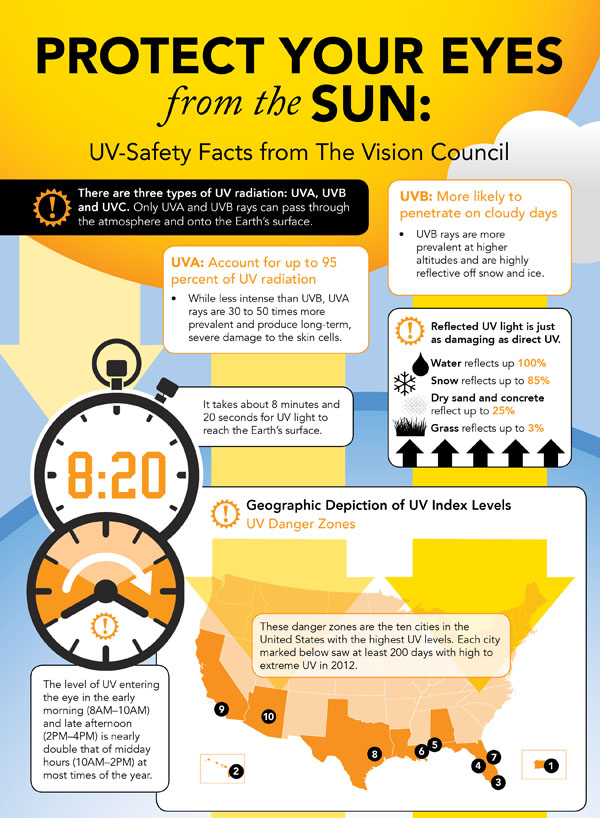Prevent Blindness, the nation’s eye health and safety organization, declares May as UV (ultraviolet) Awareness Month. Many people are well aware about the damage that UV rays can have on the skin, but most are unaware of the damage it can cause to the eyes.
What is this invisible threat exactly? And how does it impact us? This ultraviolet radiation is measured in nanometers (nm). It is categorized in three basic terms and classified by the strength of the UV ray:
- UVC: These rays are below 280 nm. The upper atmosphere absorbs these, so they do not reach us, therefore protection from these rays is not overly necessary.
- UVB: These are between 315 – 380 nm. These manage to make it to the earth’s surface and are notorious for damaging sight. They can cause snow blindness but are notably responsible for sunburn and several types of skin cancer. Research has shown that these rays are strongest during the summer and at higher altitudes.
- UVA: These are the most dangerous being 315 – 380 nm. They are known for causing chronic eye damage. Studies have indicated that these rays get absorbed by the lenses of our eyes leading to damage of the retina. They contribute to the occurrence of cataracts, are also a major cause of aging and unfortunately can pass through clouds, glass, water and clothing.
Exposure to ultraviolet rays can instantaneously temporarily cause damage to the cornea and the conjunctiva. Symptoms associated with this condition, known as Ultraviolet Keratitis, include eye pain, tears, blurred vision and light sensitivity. These symptoms may last anywhere from 6 to 48 hours after exposure. While this condition may only be temporary, it goes to show the effects UV rays have on vision. Forms of UV damage can be cumulative and later lead to cataracts or macular degeneration later in life.
There are additionally a number of skin cancers that can occur on the eyelids, on the surface of the eye, or inside the eye. Cancers such as basal cell carcinoma, squamous cell carcinoma and melanoma are all potential risks of UV exposure, particular those with fair skin, light colored eyes, those who are exposed to prolonged time in the sun or tanning beds, and smokers.
But what about Vitamin D? A little sun exposure is healthy for us, right? Vitamin D is essential to help your body absorb calcium and promote bone growth. Vitamin D is also beneficial for other important body functions and it has been shown to be essential to a healthy immune system. However, just 5-15 minutes in the sun is enough to help stimulate the production of Vitamin D.
When we are caught up in the delightful pursuits of summer– we tend to overlook the simple proactive measures that we can take to protect against vision loss and UV related eye damage and even life-threatening ocular cancers. In addition to taking a few extra moments to protect yourself and your loved ones before rushing out into the sunshine, it is imperative that people take the time for annual eye exams. An optomap screening is an excellent, expedient way to get a comprehensive view of the retina and to gain essential information about one’s ocular health. optomap is the only proven, clinically-validated, ultra-widefield retinal image that can capture up to 200⁰ of the retina, which can reveal incredibly subtle changes from the central pole to the far periphery of the retina in a single capture – and in a fraction of a second – so you can get out there (sunglasses on) and enjoy that summer sun.

